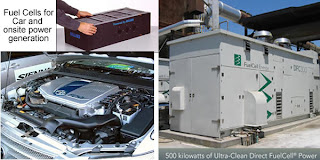Power Generation and Distribution in SingaporePresently, Singapore imports natural gas from Malaysia and Indonesia and bulk of which are for power generation. About 80% of Singapore’s total power demand of 5,000MW are from natural gas. Singapore has 8 power generating companies and one power distribution company, called the PowerGrid.
What is MicroPower Generation?MicroPower Generation more refers to on-site, small scale power generation that uses alternative source of energies such as wind, solar, natural gas and other energies. Overseas examples, especially those in US, will show that one can use natural gas to power Fuel Cells and Microturbines to generate electricity, heat and cooling on site for homes and offices. Judging from the sales of the companies selling these products, there is an increasing trend for on-site MicroPower generation. Presently, on-site generation systems in US are producing 135 billion Kwh per year or about 3.6 percent of U.S's generation
What is Fuel Cell and what is Micro-Turbine?
Fuel Cell is an electrochemical device that produces electricity silently without combustion. In a Fuel Cell, electricity can be generated by combining hydrogen fuel extracted from natural gas and the oxygen derived from air. Fuel cells can produce enough heat to generate cooling as well as heating for use in homes and offices. Fuel cell, like battery, has no moving parts except for the chemical reactions between hydrogen and oxygen. Fuel Cells can be packed to power a car or on site to supply energies to building complexes.

Microturbines are actually miniature combustion turbines that have been used in small jets or as auxiliary units in airplanes. It has approximately the size of a refrigerator and can generate electricity from 25 KW to about 500 kW. Similar to Fuel Cells, Microturbines can also generate cooling as well as heating energies. The details and the workings of the Microturbine can be found here.

For efficient use of natural gas, Fuel Cells and Microturbines are sometimes combined such that waste heats from Fuel Cells are used in the Microturbine and vice versa.
Why MicroPower Generation?
Large power plants are 15-20% less efficient than MicroPower generation because they can’t make use of the waste heat effectively; also, there are losses over long transmission lines. Examples in US show that investment in Fuel cells or Microturbines can be repaid in the period between 3 to 5 years depending on the differences in the rates between electricity and natural gas. The rate increase in favor of natural gas will force more users to consider the use of MicroPower generation.
Can I use MicroPower at Home?Today’s Fuel Cells and Microturbines from the stores have generation capacities above 25KW which is too big for home that requires only about 3 KW of electricity. They would be more suitable for residential complex, offices or factories, which usually consume more than 25 KW; however, there is an experiment that uses Fuel Cells to power a house in UK.
What About Cost?Microturbine will cost roughly US$1,200 to US$1,500/= per KW whereas Fuel cells, 4 times as much at US$5,000 to US$10,000 per kilowatt. However, Fuel Cells have lower operating cost of about US$0.07 to US$0.08 per Kwh as compared to US$0.10 per Kwh in the case of Microturbine. There were examples that the cost of these installations can be recouped within a period less than 5 years basing on today’s natural gas and electricity rates. In comparison, a normal power generation plant will
cost around US$ 650 per KW.
Would the Authority Permits?The generation and distribution of electricity in Singapore is regulated by Energy Market Authority (EMA). Present regulations do not permit anyone to retail electricity without first obtaining a licence from EMA; however, there are isolated cases where MNCs have generated power for use in their own hi-tec plants. Islandwide, ENV has permission to generate electricity from the refuses in incinerators.
Can I Connect to the Grid?There are reports that users of MicroPower in US have connected their devices and sell excess electricity to the Grid. However, it is not expected that PowerGrid will permit such connection when Microturbines and Fuel Cells become available, not until when there are regulatory policy on such connection.
Policies in other Parts of the WorldUS, Canada and European countries have regulatory policies governing on-site power generation to promote the use of MicroPower generation. This is because MicroPower generation is in-line with the Governments’ Distributed Generation (DG) policy that helps to ease power generation pressures in the countries. For example in US, the Public Utility Regulatory Policy Acts of 1978 stipulates the right for users of small generating plants to sell power to Public Utilities. These countries also offer incentives, such as cash rebates, for the use of Fuel Cells and Microturbines.
What are the limitations?Unlike electricity, Fuel Cells and Microturbine will need a few minutes for starting up; they are not instantaneous. These MicroPower plants are cost effective only when they are constantly in operation with a minimum base load; therefore, connection to the power grid is essential for economical operation. Besides the higher first cost, these MicroPower devices will occupy space and require fire safety consideration.
Conclusion
The use of natural gas will give an opportunity for Singaporean to consider on-site generation of electricity. Examples in US show that these MicroPower plants can be cost effective. Whether Singaporeans can effectively use the MicroPower plants will much depend on the Government’s policy for on-site generation.




No comments:
Post a Comment